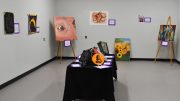Passionate about his Anishinaabe-Métis roots, third-year U of M native studies student Jack Theis became a beadworker as a means to connect with his ancestors.
“All my life pretty much, I’ve been obsessed with my ancestors,” he said, “because I was raised on their stories, their photos.”
“Being raised in Dallas, [Texas,] which is hundreds, even thousands, of miles away from any of my homelands, the only way I could connect with my culture and my ancestors, or one of the only ways I could connect with them, was through art.”
Moving to Minneapolis at 22 with the hope of reconnecting with his ancestral roots, Theis discovered “a culture of beadwork […] in the Twin Cities.”
“I was willing to learn beadwork from any Native person in the community,” he said.
“I’m very grateful to my Dakota friends for teaching me […] [how to do beadwork] because that’s been an integral form of connecting with my ancestors and it’s led to so many other things in my life.”
While in Minneapolis, Theis began beading portraits of his ancestors and “their photos that I grew up with which are all in black and white from the 1800s and turn of the century.”
“So that I can invite them to be in my life and to be with me at all times […] to keep them close by,” he said.
After moving to Winnipeg three years ago, Theis discovered “twice as many beadwork circles” and began focusing on traditional Ojibwa and Métis beadwork designs.
This past summer, Theis was an Indigenous scholar-in-residence at the Manitoba Museum where the inspiration for his next big project came to him.
Theis said he “got to do extensive archival research in both the Manitoba Museum archives as well as the Parks Canada archives.”
At the end of the research, Theis said he was supposed to do a project, “preferably involving beadwork.”
“For my project I wanted to focus on my ancestors,” he said, “so I decided that I would use this passage in the journals of Alexander Henry (the Younger).”
Theis recounted that this passage is an eyewitness account written in 1803 that depicts his ancestors and several other families getting ready to depart for a smaller satellite fort in the Pembina Hills for the winter months.
“This may be one of the only eyewitness accounts of my ancestor,” Theis said.
“It’s a very vivid and beautiful passage.”
Theis said the passage had been used in academic texts to describe the culture of this region at the time.
“But this has never been depicted in any way through art,” he said, “so I was like, ‘This is a perfect chance for me to get a hide’ […] I started beading the image. I did hours and hours and hours of research, I mean, just to make sure it’s historically accurate.”
Theis wants to bead each family along the edges of the hide in detail, down to each family’s cart and horses.
“So that it looks like […] they’re moving,” he said, “it’s not just pictures on a hide up and down, and that way you have to move if you want to view the piece, you have to move around the hide.”
The purpose of Theis’s project is “to break down a bunch of stereotypes about Indigenous life at the time about Indigenous histories and identities — stereotypes that I’m met with all the time that I’m tired of breaking down.”
Theis’s hide project has been requested to be exhibited at a museum and the Festival du Voyageur has asked him to present it at this year’s festival.
As well, his ancestral portrait project that he started while in Minneapolis has been requested by a gallery and a museum in Winnipeg.
“The homeland is definitely the place for me,” he said.
Though Theis thinks more can be done at the University of Manitoba to promote beadwork as a high art form, he believes it is still not seen in this light.
“It’s not white art,” he said.
“It’s connected to women. A lot of beadworkers are women, historically and currently. […] Women have, in all areas of art — European art, Indigenous art — have always been kind of cast aside, but you know, of course, Indigenous women, it’s tenfold.”
As for who gets to do beadwork, Theis said “beadwork as an artform — no one really owns that.”
“Humans have been doing that for, like, a hundred thousand years.”
However, Theis emphasized that Indigenous people “have the right to safeguard our ancestors’ designs and our peoples’ designs.”
“I’m not against white people teaching a class on beadwork,” he said.
“It depends on what’s being taught, so if you’re trying to teach a class on […] Métis beadwork, but you’re not Métis, there’s a slight issue there and if you’re not Indigenous at all there’s a huge issue there.”
For Theis, beadwork is a form of cultural resistance and survival.
“I don’t want all the beadwork that I do to be just a piece of art, or something that looks pretty,” he said.
“I want it to make a statement and I want it to be a form of healing, survival, resistance, education, all of that.”





